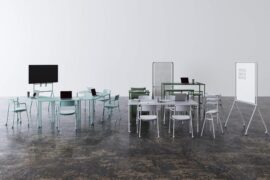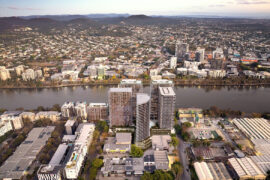The newly opened National Herbarium of New South Wales will help lead vital plant science and research. Architectus gives us the inside story from the official opening ceremony.

May 2nd, 2022
The brand new National Herbarium of New South Wales has officially opened, and with the cutting of the ribbon becomes the largest plant science facility this side of the equator.
Designed by Architectus in collaboration with Richard Leplastrier and landscape architect Craig Burton, the Herbarium is imagined as a seed pod, protecting the inner layers from bushfire and other catastrophic conditions. Located at the Australian Botanical Gardens, six vaults concealed by 400mm thick rammed earth walls are topped by a 36-metre long ‘fly-roof’ which protects from rain and shades the vaults while providing greater cover on external terraces for visitors.
Over one million botanical specimens are kept within the facility that is regarded as a critical resource for the decision making around conservation and management of local flora. Architectus senior associate, Eric Lee, says the practice endeavoured to create a precinct that would serve as a learning hub for the general public.

“One of the important components of the brief, which goes outside the facility, is the integration of building into the general master plan of the Botanic Gardens. I think any good design has one solution for many problems. We were able to create a facility for the needs of scientists and the general public, and were able to meld those two things together,” he says.
Upon winning the design competition for the Herbarium in 2018, Architectus hosted a series of collaborative design sessions with the Australian Institute of Botanical Science staff. These sessions resulted in a space that thoughtfully and expertly supports the required environmental conditions and quarantine procedures to protect the botanical specimens from degradation and insect infestation. An open-plan office connects to the surrounding gardens and provides administrative space for researchers. The new building’s public interface allows the facility to promote its work to visitors.
The building’s design considers centralised ecologically sensitive and energy-saving features. The vaults contain several layers of protection to ensure their survival in the event of inclement weather. This includes an insulated internal box, as well as the rammed earth walls. South-facing windows ensure a gentle amount of natural light works itself into the building without over-saturating the spaces, while the roof features a photovoltaic system and the capacity to harvest rainwater.
Related: How ‘well’ is your science lab, with HDR?

“The building wants to resonate with the landscape, and what we were looking to do was bring inside spaces out, and the outside spaces in,” says Lee.
The materiality of the vaults works both inside and out, and even on the lab side of the buildings we have created those forms so they come inside as well, which gives a spatial quality to the building which makes it permeable so you can actually feel the spaces outside.”
Architectus principal, Luke Johnson, says the entire design process has been one the practice has thoroughly enjoyed.
“Working with the Royal Botanic Gardens and Domain Trust has been a privilege. The Herbarium is an environmentally remarkable project as plants are central to our planet’s habitability and sustainability. The research and visitor interaction with the facility’s extensive botanical collection will open the door for positive environmental and societal outcomes well into the future.”

A number of Dharawal elders were consulted throughout the design process, as the site is significant for Aboriginal heritage and was once a gathering place for the Dharawal people. The purpose-built facility joins the award-winning Australian PlantBank and extensive Living Collection at the Australian Botanic Garden Mount Annan, reinforcing the Australian Institute of Botanical Science as an international leader in plant science.
“We are ecstatic to officially open the new National Herbarium of New South Wales, securing the conservation of some of the most significant botanical resources in the Southern Hemisphere,” says chief executive of the Royal Botanic Gardens and Domain Trust, Denise Ora.
“Herbarium specimens are essential for informing decisions about the conservation of our natural environment and the new state-of-the-art facilities will help our world-class experts better utilise the collection to lead vital plant science and research on a local, national and global scale.”
For more information, visit National Herbarium of New South Wales.
Architectus
architectus.com.au
Photography
Opening ceremony images by Brett Boardman; hero image courtesy of Architectus

We think you might like this article about a lively and creative dialogue for reconciliation in Australia.
INDESIGN is on instagram
Follow @indesignlive
A searchable and comprehensive guide for specifying leading products and their suppliers
Keep up to date with the latest and greatest from our industry BFF's!

For Aidan Mawhinney, the secret ingredient to Living Edge’s success “comes down to people, product and place.” As the brand celebrates a significant 25-year milestone, it’s that commitment to authentic, sustainable design – and the people behind it all – that continues to anchor its legacy.

Welcomed to the Australian design scene in 2024, Kokuyo is set to redefine collaboration, bringing its unique blend of colour and function to individuals and corporations, designed to be used Any Way!

Across four decades, Leone Lorrimer LFRAIA GAICD reshaped Australian architecture through strategic vision, global influence and fearless leadership.

‘Come Together’ takes a global view of multigenerational design, an increasingly popular phenomenon with some especially notable examples in Australia.
The internet never sleeps! Here's the stuff you might have missed

Plus Studio and ICD Property have submitted a proposal for a development on Brisbane’s Donkin Street, using a 1.68-hectare former industrial site as a new riverside residential and community destination.

Community, Country and climate were centred at the 2025 Australian Institute of Landscape Architects (AILA) Awards in Lutruwita/Tasmania on 21st October.

Central Station by Woods Bagot in collaboration with John McAslan + Partners has been named one of two joint winners of The Building category at the INDE.Awards 2025. Recognised alongside BVN’s Sirius Redevelopment, the project redefines Sydney’s historic transport hub through a transformative design that connects heritage with the demands of a modern, growing city.